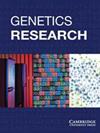Sirt3 Regulates Response to Oxidative Stress by Interacting with BER Proteins in Colorectal Cancer
IF 2.1
4区 生物学
Q4 GENETICS & HEREDITY
引用次数: 2
Abstract
The oxidative damages are well-recognized factors in the pathogenesis of colorectal cancer (CRC). Increased levels of reactive oxygen species (ROS) can lead to oxidative DNA damage, which, if unrepaired, can be an underlying cause of cancerogenic transformation. To defend against these threats, cells have developed a range of defense mechanisms. One of the most important protection mechanisms is DNA repair systems, both nuclear and mitochondrial. Sirt3 is a mitochondrial protein involved in regulating NEIL1, NEIL2, MUTYH, APE1, and LIG3 proteins, which are involved in DNA repair, including mitochondrial repair through mtBER (mitochondrial Base Excision Repair). In this work, we show that NEIL1, NEIL2, MUTYH, APE1, and LIG3 are regulated by Sirt3 through deacetylation, and moreover, Sirt3 is directly involved in physical interaction with MUTYH, NEIL1, and APE1, which indicates the controlling role of Sirt3 over the mtBER mechanism. Also, if the cells deprived of Sirt3 are exposed to oxidative stress, altered levels of those proteins can be observed, which supports the theory of the regulatory role of Sirt3. Finally, to fully confirm the role of Sirt3 in DNA repair, we examined its role in apoptosis and found the impact of this protein on cell survival rate. Using the knowledge obtained in the course of conducted experiments, we postulate consideration of Sirt3 as a target in the rising vulnerability of cancer cells during therapy and therefore increasing the effectiveness of cancer treatment.Sirt3通过与BER蛋白相互作用调节结直肠癌对氧化应激的反应
氧化损伤是结直肠癌(CRC)发病机制中公认的因素。活性氧(ROS)水平的增加可导致DNA氧化损伤,如果不修复,可能是致癌转化的潜在原因。为了抵御这些威胁,细胞发展了一系列防御机制。最重要的保护机制之一是DNA修复系统,包括细胞核和线粒体。Sirt3是一种线粒体蛋白,参与调节NEIL1、NEIL2、MUTYH、APE1和LIG3蛋白,这些蛋白参与DNA修复,包括通过mtBER(线粒体碱基切除修复)进行的线粒体修复。在这项工作中,我们发现NEIL1, NEIL2, MUTYH, APE1和LIG3通过去乙酰化受到Sirt3的调控,并且Sirt3直接参与MUTYH, NEIL1和APE1的物理相互作用,这表明Sirt3在mtBER机制中起着控制作用。此外,如果剥夺Sirt3的细胞暴露于氧化应激,可以观察到这些蛋白质水平的改变,这支持了Sirt3调节作用的理论。最后,为了充分证实Sirt3在DNA修复中的作用,我们研究了Sirt3在细胞凋亡中的作用,并发现了该蛋白对细胞存活率的影响。利用在实验过程中获得的知识,我们假设在治疗过程中考虑Sirt3作为癌细胞易感性增加的靶点,从而提高癌症治疗的有效性。
本文章由计算机程序翻译,如有差异,请以英文原文为准。
求助全文
约1分钟内获得全文
求助全文
来源期刊

Genetics research
生物-遗传学
自引率
6.70%
发文量
74
审稿时长
>12 weeks
期刊介绍:
Genetics Research is a key forum for original research on all aspects of human and animal genetics, reporting key findings on genomes, genes, mutations and molecular interactions, extending out to developmental, evolutionary, and population genetics as well as ethical, legal and social aspects. Our aim is to lead to a better understanding of genetic processes in health and disease. The journal focuses on the use of new technologies, such as next generation sequencing together with bioinformatics analysis, to produce increasingly detailed views of how genes function in tissues and how these genes perform, individually or collectively, in normal development and disease aetiology. The journal publishes original work, review articles, short papers, computational studies, and novel methods and techniques in research covering humans and well-established genetic organisms. Key subject areas include medical genetics, genomics, human evolutionary and population genetics, bioinformatics, genetics of complex traits, molecular and developmental genetics, Evo-Devo, quantitative and statistical genetics, behavioural genetics and environmental genetics. The breadth and quality of research make the journal an invaluable resource for medical geneticists, molecular biologists, bioinformaticians and researchers involved in genetic basis of diseases, evolutionary and developmental studies.
 求助内容:
求助内容: 应助结果提醒方式:
应助结果提醒方式:


